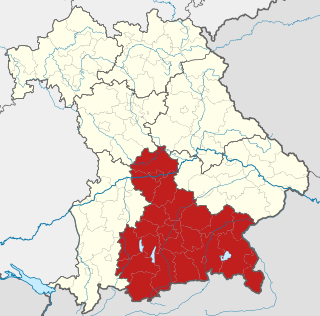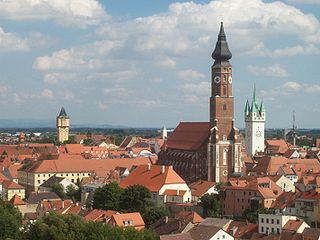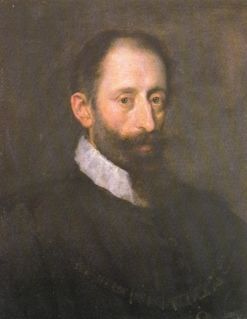
Abensberg is a town in the Lower Bavarian district of Kelheim, in Bavaria, Germany, lying around 30 km southwest of Regensburg, 40 km east of Ingolstadt, 50 northwest of Landshut and 100 km north of Munich. It is situated on the Abens river, a tributary of the Danube.

Upper Bavaria is one of the seven administrative districts of Bavaria, Germany.

Ingolstadt is a city in Bavaria, Germany, on the banks of the Danube, in the centre of Bavaria. In 2016, it had 133,638 citizens, making it the fifth largest city in Bavaria. It is part of the Munich Metropolitan Region.

The University of Ingolstadt was founded in 1472 by Louis the Rich, the Duke of Bavaria at the time, and its first Chancellor was the Bishop of Eichstätt. It consisted of five faculties: humanities, sciences, theology, law, and medicine, all of which were contained in the Hoheschule. The university was modeled after the University of Vienna. Its chief goal was the propagation of the Christian faith. The university closed in May 1800, by order of the Prince-elector Maximilian IV.

Landshut is a town in Bavaria in the south-east of Germany. Situated on the banks of the River Isar, Landshut is the capital of Lower Bavaria, one of the seven administrative regions of the Free State of Bavaria. It is also the seat of the surrounding district, and has a population of more than 70,000. Landshut is the largest city in Lower Bavaria, followed by Passau and Straubing, and Eastern Bavaria's second biggest city.

Petrus Apianus, also known as Peter Apian, Peter Bennewitz, and Peter Bienewitz, was a German humanist, known for his works in mathematics, astronomy and cartography. His work on "cosmography", the field that dealt with the earth and its position in the universe, was presented in his most famous publications, Astronomicum Caesareum (1540) and Cosmographicus liber (1524). His books were extremely influential in his time, with the numerous editions in multiple languages being published until 1609. The lunar crater Apianus and asteroid 19139 Apian are named in his honour.

Straubing is an independent city in Lower Bavaria, southern Germany. It is seat of the district of Straubing-Bogen. Annually in August the Gäubodenvolksfest, the second largest fair in Bavaria, is held.

William V, called the Pious, was Duke of Bavaria from 1579 to 1597.

William IV was Duke of Bavaria from 1508 to 1550, until 1545 together with his younger brother Louis X, Duke of Bavaria. He was born in Munich to Albert IV and Kunigunde of Austria, a daughter of Emperor Frederick III.
Albert III the Pious of Bavaria-Munich, since 1438 Duke of Bavaria-Munich. He was born in Wolfratshausen to Ernest, Duke of Bavaria and Elisabetta Visconti, daughter of Bernabò Visconti.
Ernest of Bavaria-Munich, , from 1397 Duke of Bavaria-Munich.

Stephen II was Duke of Bavaria from 1347 until his death. He was the second son of Emperor Louis IV the Bavarian by his first wife Beatrice of Silesia and a member of the Wittelsbach dynasty.
Henry XVI of Bavaria, , since 1393 Duke of Bavaria-Landshut. He was a son of duke Frederick and his wife Maddalena Visconti, a daughter of Bernabò Visconti.

Bavaria-Landshut was a duchy in the Holy Roman Empire from 1353 to 1503.

This article is intended to give an overview about the architecture of Munich, Germany.

Ingolstadt Hauptbahnhof is a railway station in the Bavarian city of Ingolstadt, situated in southern Germany. Ingolstadt station is an important junction in the Deutsche Bahn network. It has 7 platform tracks and is classified by Deutsche Bahn as a category 2 station.

Burghausen Castle in Burghausen, Upper Bavaria, is the longest castle complex in the world, confirmed by the Guinness World Record company.

Jacopo Strada was an Italian polymath courtier, painter, architect, goldsmith, inventor of machines, numismatist, linguist, collector, and merchant of works of art. His portrait by Titian has kept his image familiar.

Michael Wening was a Bavarian engraver who is known for his many depictions of important places in the Bavaria of his day, including cityscapes and views of stately homes, castles and monasteries. The work has great historical value.

Jakob Rem was an Austrian member of the Society of Jesus, a Catholic evangelical organization, and an early member of the Congregation of Marian Fathers. He introduced the phrase Mater admirablis into the litany.
















